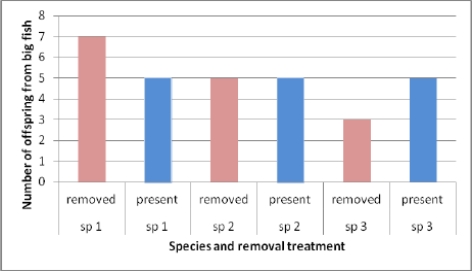Multiple Choice
 A biologist is studying three species of small fish (sp 1, sp 2, and sp 3) that cling to the bodies of bigger fish and consume parasites on the larger fish. He conducts an experiment with three treatments. In each treatment, he removes a different one of the small fish species from a large fish and examines the number offspring produced by the large fish. Which of the following conclusions are supported by the data shown in the figure?
A biologist is studying three species of small fish (sp 1, sp 2, and sp 3) that cling to the bodies of bigger fish and consume parasites on the larger fish. He conducts an experiment with three treatments. In each treatment, he removes a different one of the small fish species from a large fish and examines the number offspring produced by the large fish. Which of the following conclusions are supported by the data shown in the figure?
A) Species 1 is a mutualist.
B) Species 2 is a mutualist.
C) Species 3 is a mutualist.
D) Species 1 and 2 are mutualists.
E) Species 2 and 3 are mutualists.
Correct Answer:

Verified
Correct Answer:
Verified
Q15: <img src="https://d2lvgg3v3hfg70.cloudfront.net/TB7728/.jpg" alt=" (Figure 17.15) This
Q16: Of the following types of mutualisms, which
Q17: Ants have a mutualism with the forest
Q18: Imagine that an acacia tree in the
Q19: Under which circumstance do we tend to
Q21: What condition of large mammals do oxpecker
Q22: Garlic mustard is a plant that has
Q23: If you removed mutualistic ants from acacia
Q24: In the interaction between damselfish and cleaner
Q25: If oxpecker birds went extinct, what would